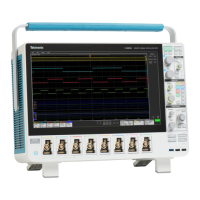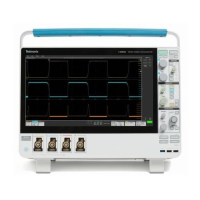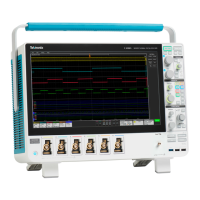Measurement variables
By knowing how the instrument makes calculations, you may better understand how to use your instrument and how to interpret
your results. The instrument uses a variety of variables in its calculations. These include:
High, low. High is the value used as the 100% level in measurements such as fall time and rise time. For example, if you request
the 10% to 90% rise time, then the instrument calculates 10% and 90% as percentages with High representing 100%.
Low is the value used as the 0% level in measurements such as fall time and rise time.
The exact meaning of High and Low depends on which of two calculation methods you choose from the High-Low Setup item of
the Measure menu. These are Min-max and Histogram.
Min-Max method. defines the 0% and the 100% waveform levels as the lowest amplitude (most negative) and the highest
amplitude (most positive) samples. The min-max method is useful for measuring frequency, width, and period for many types of
signals. Min-max is sensitive to waveform ringing and spikes, however, and does not always measure accurately rise time, fall
time, overshoot, and undershoot.
The min-max method calculates the High and Low values as follows:
High = Max
and
Low = Min
Histogram method. attempts to find the highest density of points above and below the waveform midpoint. It attempts to ignore
ringing and spikes when determining the 0% and 100% levels. This method works well when measuring square waves and pulse
waveforms.
The oscilloscope calculates the histogram-based High and Low values as follows:
1. It makes a histogram of the record with one bin for each digitizing level (256 total).
2. It splits the histogram into two sections at the halfway point between Min and Max (also called Mid).
3. The level with the most points in the upper histogram is the High value, and the level with the most points in the lower
histogram is the Low value. (Choose the levels where the histograms peak for High and Low)
If Mid gives the largest peak value within the upper or lower histogram, then return the Mid value for both High and Low (this
is probably a very low amplitude waveform).
If more than one histogram level (bin) has the maximum value, choose the bin farthest from Mid.
This algorithm does not work well for two-level waveforms with greater than about 100% overshoot.
HighRef, MidRef, LowRef, Mid2Ref. You set the various reference levels, through the Reference Level selection of the Measure
menu. They include:
HighRef. the waveform high reference level. Used in fall time and rise time calculations. Typically set to 90%. You can set it from
0% to 100% or to a voltage level.
MidRef. the waveform middle reference level. Typically set to 50%. You can set it from 0% to 100% or to a voltage level.
LowRef. the waveform low reference level. Used in fall and rise time calculations. Typically set to 10%. You can set it from 0% to
100% or to a voltage level.
Mid2Ref. the middle reference level for a second waveform (or the second middle reference of the same waveform). Used in
delay time calculations. Typically set to 50%. You can set it from 0% to 100% or to a voltage level.
Oscilloscope reference
DPO70000SX, MSO/DPO70000DX, MSO/DPO70000C, DPO7000C, and MSO/DPO5000B Series 687

